The AMD Radeon R9 290X Review
by Ryan Smith on October 24, 2013 12:01 AM EST- Posted in
- GPUs
- AMD
- Radeon
- Hawaii
- Radeon 200
Battlefield 3
Our major multiplayer action game of our benchmark suite is Battlefield 3, DICE’s 2011 multiplayer military shooter. Its ability to pose a significant challenge to GPUs has been dulled some by time and drivers, but it’s still a challenge if you want to hit the highest settings at the highest resolutions at the highest anti-aliasing levels. Furthermore while we can crack 60fps in single player mode, our rule of thumb here is that multiplayer framerates will dip to half our single player framerates, so hitting high framerates here may not be high enough.
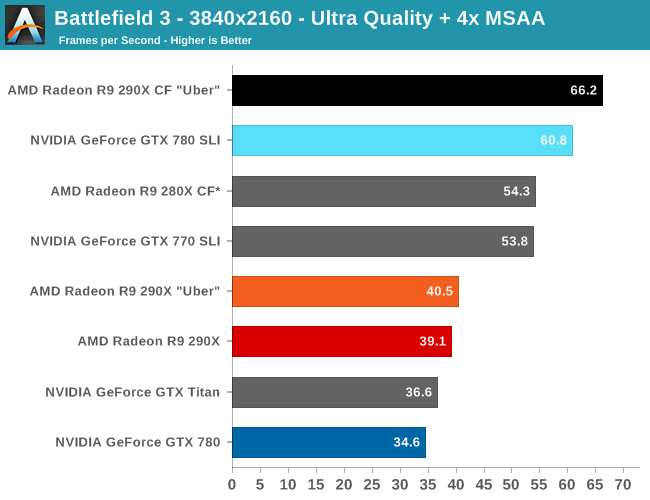

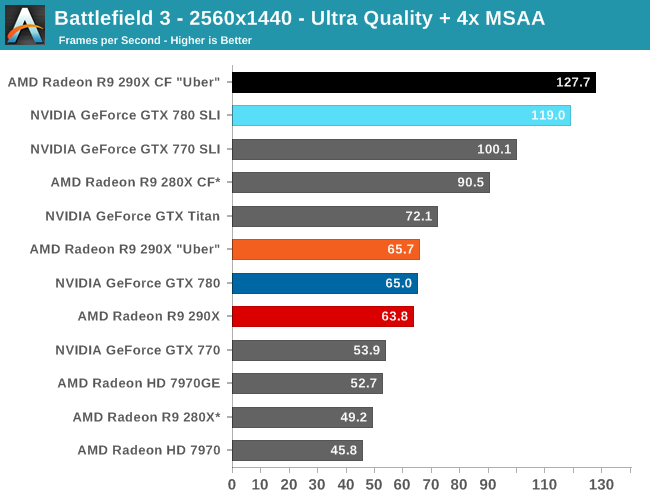
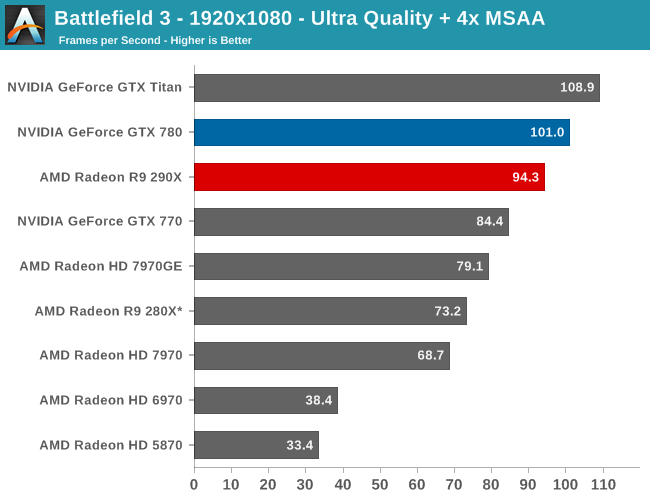
For our Battlefield 3 benchmark NVIDIA cards have consistently been the top performers over the years, and as a result this is one of the hardest fights for any AMD card. So how does the 290X fare? Very well, as it turns out. The slowest game for the 290X (relative to the GTX 780) has it losing to the GTX 780 by just 2%, effectively tying NVIDIA’s closest competitor. Not only is the 290X once again the first single-GPU AMD card that can break 60fps average on a game at 2560 – thereby ensuring good framerates even in heavy firefights – but it’s fully competitive with NVIDIA in doing so in what’s traditionally AMD’s worst game. At worst for AMD, they can’t claim to be competitive with GTX Titan in this one.
Moving on to 4K gaming, none of these single-GPU cards are going to cut it at Ultra quality; the averages are decent but the minimums will drop to 20fps and below. This means we either drop down to Medium quality, where 290X is now performance competitive with GTX Titan, or we double up on GPUs, which sees the 290X CF in uber mode take top honors. This game happens to be another good example of how the 290X is scaling into 4K better than the GTX 780 and other NVIDIA cards are, as not only does AMD’s relative positioning versus NVIDIA cards improve, but in heading to 4K AMD picks up a 13% lead over the GTX 780. The only weak spot here for AMD will be performance scaling for multiple GPUs, as while the 290X enjoys a 94% scaling factor at 2560, that drops to 60% at 4K, at a time where NVIDIA’s scaling factor is 76%. The 290X has enough of a performance lead for the 290X CF to hold out over the GTX 780 SLI, but the difference in scaling factors will make it cut close.
Meanwhile in an inter-AMD comparison, this is the first game in our benchmark suite where the 290X doesn’t beat the 280X by at least 30%. Falling just short at 29.5%, it’s a reminder that despite the similarities between 290X (Hawaii) and 280X (Tahiti), the performance differences between the two will not be consistent.

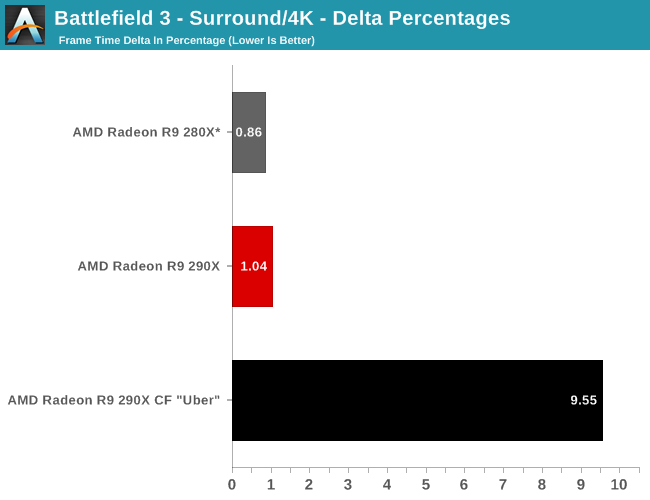
Looking at our delta percentages, this is another strong showing for the 290X CF, especially as compared to the 280X CF. AMD has once again halved their variance as compared to the 280X CF, bringing it down to sub-10% levels. This despite the theoretical advantage that the dedicated CFBI should give the 280X. However AMD can’t claim to have the lowest variance of any multi-GPU setup, as this is NVIDIA’s best game, with the GTX 780 SLI seeing a variance of only 6%. It’s a shame not all games can be like this (for either vendor) since there would be little reason not to go with a multi-GPU setup if this was the typical AFR experience as opposed to the best AFR experience.
Finally, looking at delta percentages under 4K shows that AMD’s variance has once again risen slightly compared to the variance at 2560x1440, but not significantly so. The 290X CF still holds under 10% here.


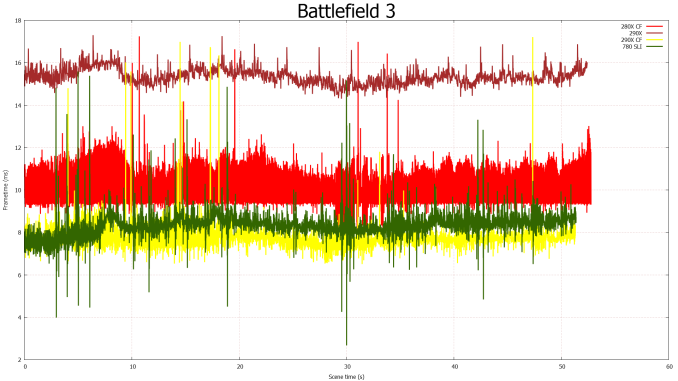
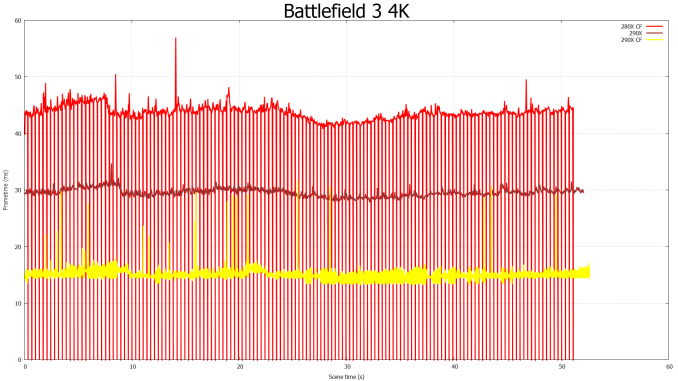








396 Comments
View All Comments
SolMiester - Monday, October 28, 2013 - link
There is no way Origin PC or any other OEM would want to put this reference card in there systems..I cant wait to see RMA stats with this card...AMD blew the card after such a great GPU...how many times will they do this?polaco - Saturday, October 26, 2013 - link
This is an interesting article too for gamers that are looking for 4K:http://www.legitreviews.com/amd-radeon-r9-290x-vs-...
dwade123 - Saturday, October 26, 2013 - link
All this shows is that GTX Titan is one efficient card. Better than both GTX 780 and AMD's offerings.ehpexs - Saturday, October 26, 2013 - link
Looks like AMD is a gen away from offereding a crossfire solution that can max out my triple crossovers @ 7680x1440Th-z - Sunday, October 27, 2013 - link
It seems AMD is pushing 290X really hard, to the point beyond its efficiency curve to try to win over larger chips with almost 1B more transistors from Nvidia. I wonder if reducing some ROPs and dedicate more die area to shader core may look like to 290X, or to go all in, designing a chip as large as Nvidia's top parts.Ytterbium - Sunday, October 27, 2013 - link
I'm sad they've gone to 1/8th FP, the 280X is a better compute card!Animalosity - Sunday, October 27, 2013 - link
Why can't people just accept that AMD has beaten Nvidia in every shape and form this time. Yeah, its always been back and forth. And it will again in the future, but for now AMD has the crown for everything except for power/sound levels. Keep in mind that not only does AMD own both next gen consoles, they are also running every one of these benchmarks on beta drivers which means that they will only continue to get better. Add mantle to the equation and Titan will have absolutely zero purpose in life. It was a good card. RIP Kepler.Vortac - Sunday, October 27, 2013 - link
Well, let's point out again that Titan has a much better FP64 performance, approx. 2.5x better than 290X, so "absolutely zero purpose" is not entirely correct. Of course, if you don't care about computing, then obviously 290X is a much better choice now.Luke7 - Sunday, October 27, 2013 - link
Are you talking about this?http://www.sisoftware.co.uk/?d=qa&f=gpu_financ...
Vortac - Sunday, October 27, 2013 - link
In this interesting review Titan is pitted against 7970 which has 1/4 FP64 performance and is indeed very good for double precision calculations, especially with OpenCL. 290X has 1/8 FP64 and its double precision performance is worse than 7970, leaving Titan with some space to breathe.